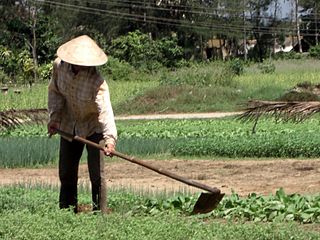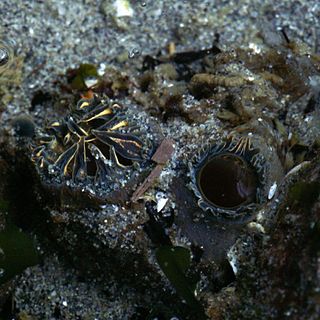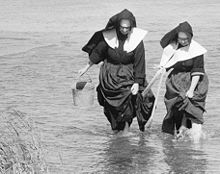
Clam is a common name for several kinds of bivalve molluscs. The word is often applied only to those that are edible and live as infauna, spending most of their lives halfway buried in the sand of the seafloor or riverbeds. Clams have two shells of equal size connected by two adductor muscles and have a powerful burrowing foot. They live in both freshwater and marine environments; in salt water they prefer to burrow down into the mud and the turbidity of the water required varies with species and location; the greatest diversity of these is in North America.

A shovel is a tool used for digging, lifting, and moving bulk materials, such as soil, coal, gravel, snow, sand, or ore. Most shovels are hand tools consisting of a broad blade fixed to a medium-length handle. Shovel blades are usually made of sheet steel or hard plastics and are very strong. Shovel handles are usually made of wood or glass-reinforced plastic (fiberglass).

The Pacific geoduck is a species of very large saltwater clam in the family Hiatellidae. The common name is derived from the Lushootseed name, gʷidəq.

A spade is a tool primarily for digging consisting of a long handle and blade, typically with the blade narrower and flatter than the common shovel. Early spades were made of riven wood or of animal bones. After the art of metalworking was developed, spades were made with sharper tips of metal. Before the introduction of metal spades manual labor was less efficient at moving earth, with picks being required to break up the soil in addition to a spade for moving the dirt. With a metal tip, a spade can both break and move the earth in most situations, increasing efficiency. A classic spade, with a narrow body and flat tip is suited for digging post holes, and is not to be confused with a "roundpoint" shovel, which has a wider body and tapered tip.

A hoe is an ancient and versatile agricultural and horticultural hand tool used to shape soil, remove weeds, clear soil, and harvest root crops. Shaping the soil includes piling soil around the base of plants (hilling), digging narrow furrows (drills) and shallow trenches for planting seeds or bulbs. Weeding with a hoe includes agitating the surface of the soil or cutting foliage from roots, and clearing the soil of old roots and crop residues. Hoes for digging and moving soil are used to harvest root crops such as potatoes.

A garden fork, spading fork, or digging fork is a gardening implement, with a handle and a square-shouldered head featuring several short, sturdy tines. It is used for loosening, lifting and turning over soil in gardening and farming, and not to be confused with the pitchfork, a similar tined tool used for moving loose materials such as hay, straw, silage, and manure.

A rake is a broom for outside use; a horticultural implement consisting of a toothed bar fixed transversely to a handle, or tines fixed to a handle, and used to collect leaves, hay, grass, etc., and in gardening, for loosening the soil, light weeding and levelling, removing dead grass from lawns, and generally for purposes performed in agriculture by the harrow.

The American oystercatcher, occasionally called the American pied oystercatcher, or PiruPiru, is a member of family Haematopodidae. Originally called the "sea pie", it was renamed in 1731 when naturalist Mark Catesby observed the bird eating oysters. The current population of American oystercatchers is estimated to be 43,000. There are estimated to be 1,500 breeding pairs along the Atlantic and Gulf Coasts of the US. The bird is marked by its black and white body and a long, thick orange beak.

The Pacific razor clam, Siliqua patula, is a species of large marine bivalve mollusc in the family Pharidae.

The Atlantic jackknife clam, Ensis leei, also known as the bamboo clam, American jackknife clam or razor clam, is a large edible marine bivalve mollusc found on the North American Atlantic coast, from Canada to South Carolina. The species has also been introduced to Europe. The name "razor clam" is also used to refer to different species such as the Pacific razor clam or Razor shell.

Tresus capax is a species of saltwater clam, marine bivalve mollusk, common name the fat gaper, in the family Mactridae. It also shares the common name horse clam with Tresus nuttallii a species which is similar in morphology and lifestyle. Both species are somewhat similar to the geoduck, though smaller, with shells up to eight inches long (20 cm), weight to 3–4 lb (1.4–1.8 kg).

Bucket and spade sets are traditional British seaside paraphernalia that can be bought cheaply from any beachside vendor. They usually consist of a small plastic bucket with a handle and a small shovel, sometimes decorated with a variety of bright colours and patterns. In North America, they are called shovels with pails.

A sand cleaning machine, beach cleaner, or (colloquially) sandboni is a vehicle that drags a raking or sifting device over beach sand to remove rubbish and other foreign matter. They are manually self-pulled vehicles on tracks or wheels or pulled by quad-bike or tractor. Seaside cities use beach cleaning machines to combat the problems of litter left by beach patrons and other pollution washed up on their shores. A chief task in beach cleaning strategies is finding the best way to handle waste matter on the beaches, taking into consideration beach erosion and changing terrain. Beach cleaning machines work by collecting sand by way of a scoop or drag mechanism and then raking or sifting anything large enough to be considered foreign matter, including sticks, stones, litter and other items.

The Atlantic surf clam, also called the bar clam, hen clam, skimmer or simply sea clam, is a very large, edible, saltwater clam or marine bivalve mollusk in the family Mactridae. It is one of the most commonly found species of bivalves in the western Atlantic Ocean. Able to reach sizes between 7.9 and 8.9 inches in length, Atlantic surf clams are much larger than Spisula solida, which also resides in the eastern Atlantic coastal waters. Atlantic surf clams reproduce in late summer, when the water temperatures peak.

Fishing techniques are methods for catching fish. The term may also be applied to methods for catching other aquatic animals such as molluscs and edible marine invertebrates.

The razor shell, Ensis magnus, also called razor clam, razor fish or spoot (colloquially), is a bivalve of the family Pharidae. It is found on sandy beaches in Canada and northern Europe.

A fishing dredge, also known as a scallop dredge or oyster dredge, is a kind of dredge which is towed along the bottom of the sea by a fishing boat in order to collect a targeted edible bottom-dwelling species. The gear is used to fish for scallops, oysters and other species of clams, crabs, and sea cucumber. The dredge is then winched up into the boat and emptied. Dredges are also used in connection with the work of the naturalist in marine biology, notably on the Challenger Expedition.

Dosewallips State Park is a public recreation area located where the Dosewallips River empties into Hood Canal in Jefferson County, Washington. The state park's 1,064 acres (431 ha) include both freshwater and saltwater shorelines. The park offers opportunities for picnicking, camping, hiking, boating, fishing, swimming, scuba diving, and shellfish harvesting.

Digging, also referred to as excavation, is the process of using some implement such as claws, hands, manual tools or heavy equipment, to remove material from a solid surface, usually soil, sand or rock on the surface of Earth. Digging is actually the combination of two processes, the first being the breaking or cutting of the surface, and the second being the removal and relocation of the material found there. In a simple digging situation, this may be accomplished in a single motion, with the digging implement being used to break the surface and immediately fling the material away from the hole or other structure being dug.
























